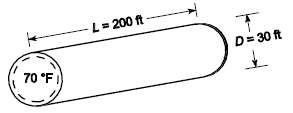A submarine is to be designed to provide a comfortable temperature for the crew of no less
Question:
A submarine is to be designed to provide a comfortable temperature for the crew of no less than 70?F. The submarine can be idealized by a cylinder 30 ft in diameter and 200 ft in length. The combined heat transfer coefficient on the interior is about 2.5 Btu/(h ft2 ?F), while on the outside the heat transfer coefficient is estimated to vary from about 10 Btu/(h ft2 ?F) (not moving) to 150 Btu/(h ft2 ?F) (top speed). For the following wall constructions, determine the minimum size in kilowatts of the heating unit required if the sea water temperatures vary from 34 to 55?F during operation. The walls of the submarine are(a) 1/2 in. aluminum(b) 3/4 in. stainless steel with a 1 in. thick layer fiberglass insulation on the inside and(c) Of sandwich construction and α 3/4in. thickness of stainless steel, a 1 in. thick layer of fiberglass insulation, and a 1/4in. thickness of aluminum on the inside. What conclusions can you draw?GIVENSubmarineInside temperature (Ti) > 70?FCan be idealized as a cylinderDiameter (D) = 30 ft length (L) = 200 ftCombined heat transfer coefficientsInside ( hci ) = 2.5 Btu/(h ft2 ?F)Outside ( hco ): not moving = 10 Btu/(h ft2 ?F)Top speed: 150 Btu/(h ft2 ?F)Sea water temperature (To) varies: 34?F ASSUMPTIONSSteady state prevailsHeat transfer can be approximated as heat transfer through a flat plate with the surface area of the cylinderConstant thermal conductivitiesContact resistance between the difference materials isnegligible

Step by Step Answer:

Principles of heat transfer
ISBN: 978-0495667704
7th Edition
Authors: Frank Kreith, Raj M. Manglik, Mark S. Bohn





